Analysis of Chatbot Adoption in Modern Society: A Comprehensive Study
VerifiedAdded on 2023/06/03
|5
|1238
|274
Report
AI Summary
This report delves into the adoption of chatbots in contemporary society, emphasizing their significance in business and customer communication. It highlights the evolution of chatbots from experimental tools to essential components of customer service, particularly in e-commerce, education, and healthcare. The report discusses the advantages of chatbots, such as improved response times and customer engagement, while also acknowledging potential drawbacks like the creation of fake user accounts. It explores the motivations behind chatbot adoption, driven by advancements in artificial intelligence and machine learning. The report also identifies challenges, including user reluctance to switch from established interfaces and the need for consumer education on the benefits of AI-driven systems. The research objectives include evaluating the development and commercialization of messaging chatbots, assessing user willingness to adopt them for social and commercial purposes, and analyzing reasons for non-adoption. The report references key studies and reports to support its analysis, providing a comprehensive overview of the current state and future prospects of chatbots.
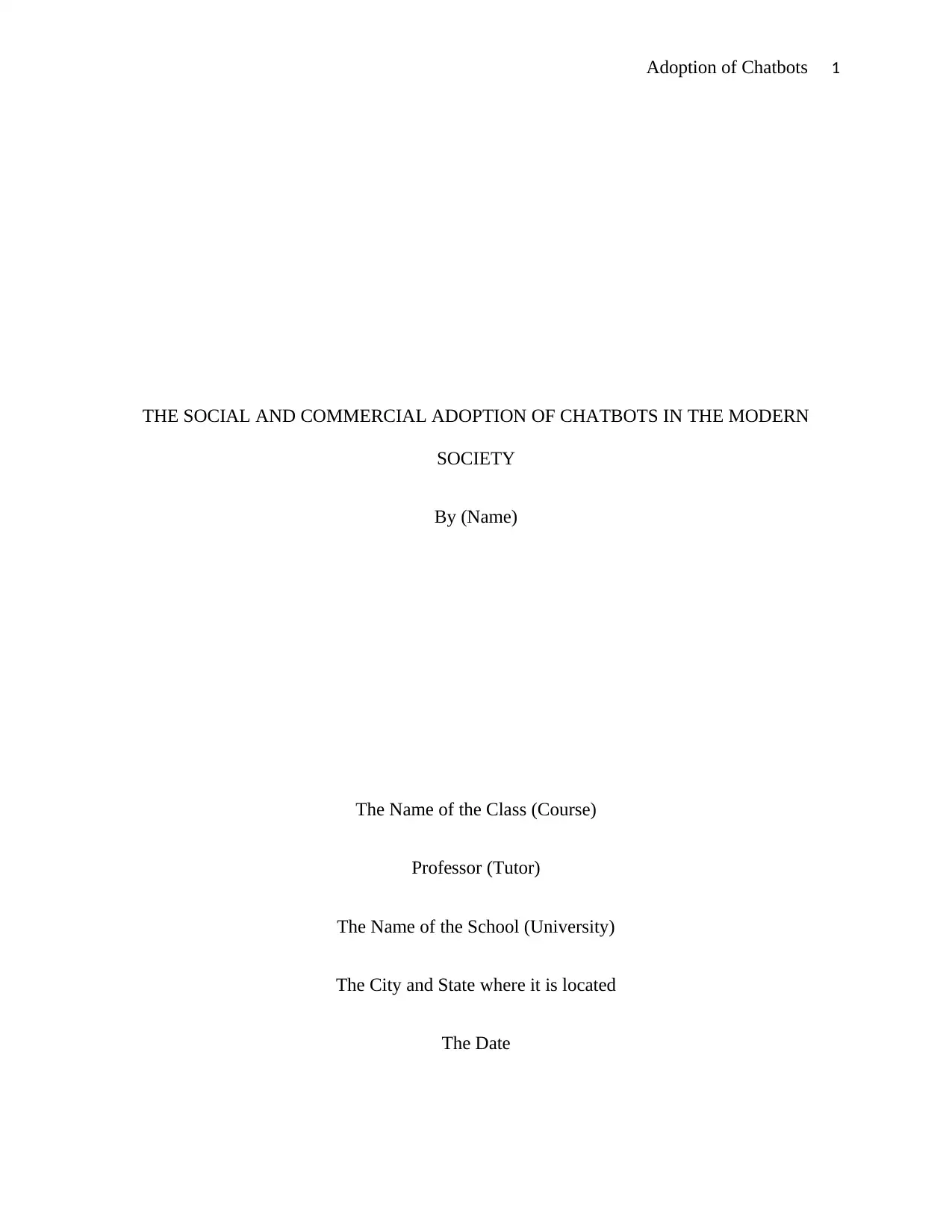
Adoption of Chatbots 1
THE SOCIAL AND COMMERCIAL ADOPTION OF CHATBOTS IN THE MODERN
SOCIETY
By (Name)
The Name of the Class (Course)
Professor (Tutor)
The Name of the School (University)
The City and State where it is located
The Date
THE SOCIAL AND COMMERCIAL ADOPTION OF CHATBOTS IN THE MODERN
SOCIETY
By (Name)
The Name of the Class (Course)
Professor (Tutor)
The Name of the School (University)
The City and State where it is located
The Date
Paraphrase This Document
Need a fresh take? Get an instant paraphrase of this document with our AI Paraphraser
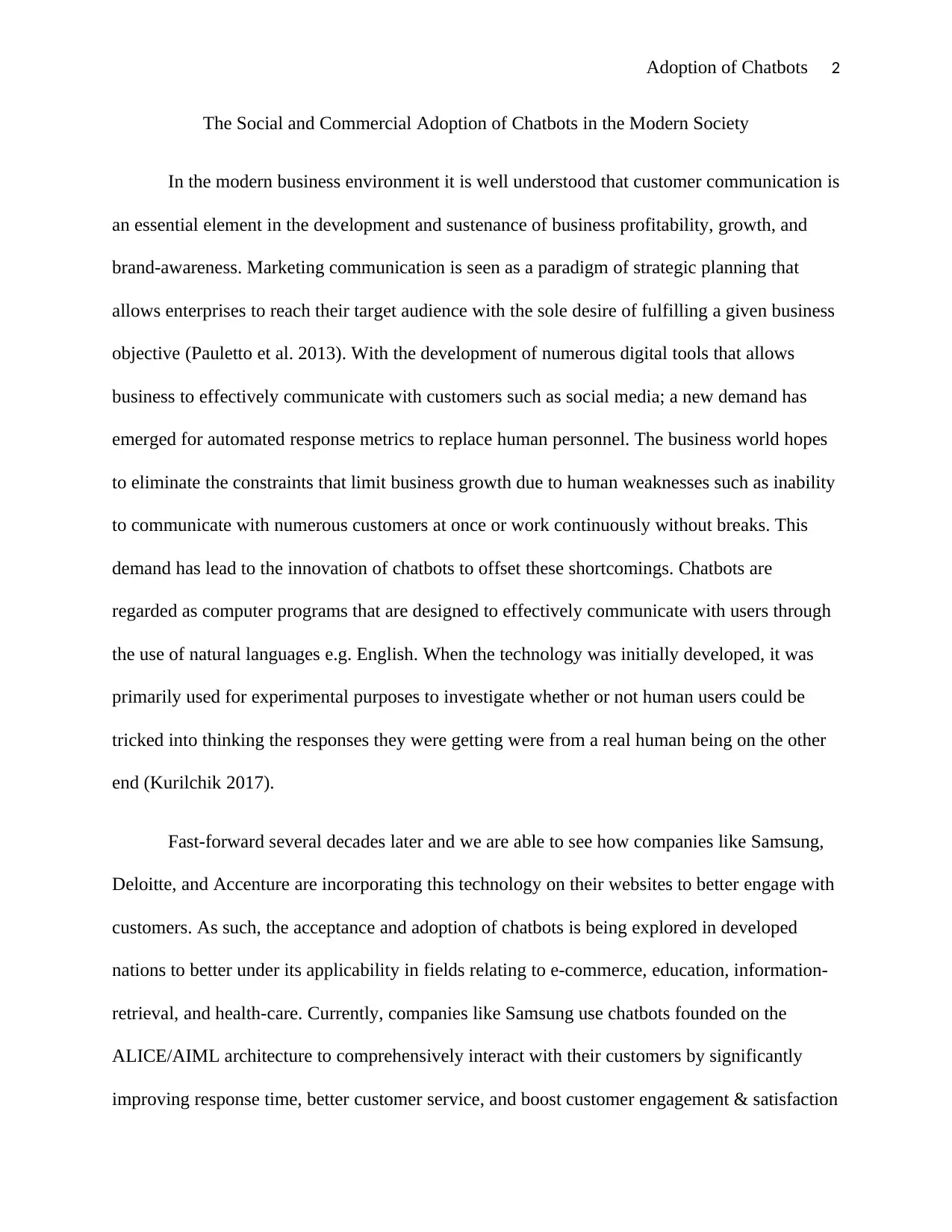
Adoption of Chatbots 2
The Social and Commercial Adoption of Chatbots in the Modern Society
In the modern business environment it is well understood that customer communication is
an essential element in the development and sustenance of business profitability, growth, and
brand-awareness. Marketing communication is seen as a paradigm of strategic planning that
allows enterprises to reach their target audience with the sole desire of fulfilling a given business
objective (Pauletto et al. 2013). With the development of numerous digital tools that allows
business to effectively communicate with customers such as social media; a new demand has
emerged for automated response metrics to replace human personnel. The business world hopes
to eliminate the constraints that limit business growth due to human weaknesses such as inability
to communicate with numerous customers at once or work continuously without breaks. This
demand has lead to the innovation of chatbots to offset these shortcomings. Chatbots are
regarded as computer programs that are designed to effectively communicate with users through
the use of natural languages e.g. English. When the technology was initially developed, it was
primarily used for experimental purposes to investigate whether or not human users could be
tricked into thinking the responses they were getting were from a real human being on the other
end (Kurilchik 2017).
Fast-forward several decades later and we are able to see how companies like Samsung,
Deloitte, and Accenture are incorporating this technology on their websites to better engage with
customers. As such, the acceptance and adoption of chatbots is being explored in developed
nations to better under its applicability in fields relating to e-commerce, education, information-
retrieval, and health-care. Currently, companies like Samsung use chatbots founded on the
ALICE/AIML architecture to comprehensively interact with their customers by significantly
improving response time, better customer service, and boost customer engagement & satisfaction
The Social and Commercial Adoption of Chatbots in the Modern Society
In the modern business environment it is well understood that customer communication is
an essential element in the development and sustenance of business profitability, growth, and
brand-awareness. Marketing communication is seen as a paradigm of strategic planning that
allows enterprises to reach their target audience with the sole desire of fulfilling a given business
objective (Pauletto et al. 2013). With the development of numerous digital tools that allows
business to effectively communicate with customers such as social media; a new demand has
emerged for automated response metrics to replace human personnel. The business world hopes
to eliminate the constraints that limit business growth due to human weaknesses such as inability
to communicate with numerous customers at once or work continuously without breaks. This
demand has lead to the innovation of chatbots to offset these shortcomings. Chatbots are
regarded as computer programs that are designed to effectively communicate with users through
the use of natural languages e.g. English. When the technology was initially developed, it was
primarily used for experimental purposes to investigate whether or not human users could be
tricked into thinking the responses they were getting were from a real human being on the other
end (Kurilchik 2017).
Fast-forward several decades later and we are able to see how companies like Samsung,
Deloitte, and Accenture are incorporating this technology on their websites to better engage with
customers. As such, the acceptance and adoption of chatbots is being explored in developed
nations to better under its applicability in fields relating to e-commerce, education, information-
retrieval, and health-care. Currently, companies like Samsung use chatbots founded on the
ALICE/AIML architecture to comprehensively interact with their customers by significantly
improving response time, better customer service, and boost customer engagement & satisfaction
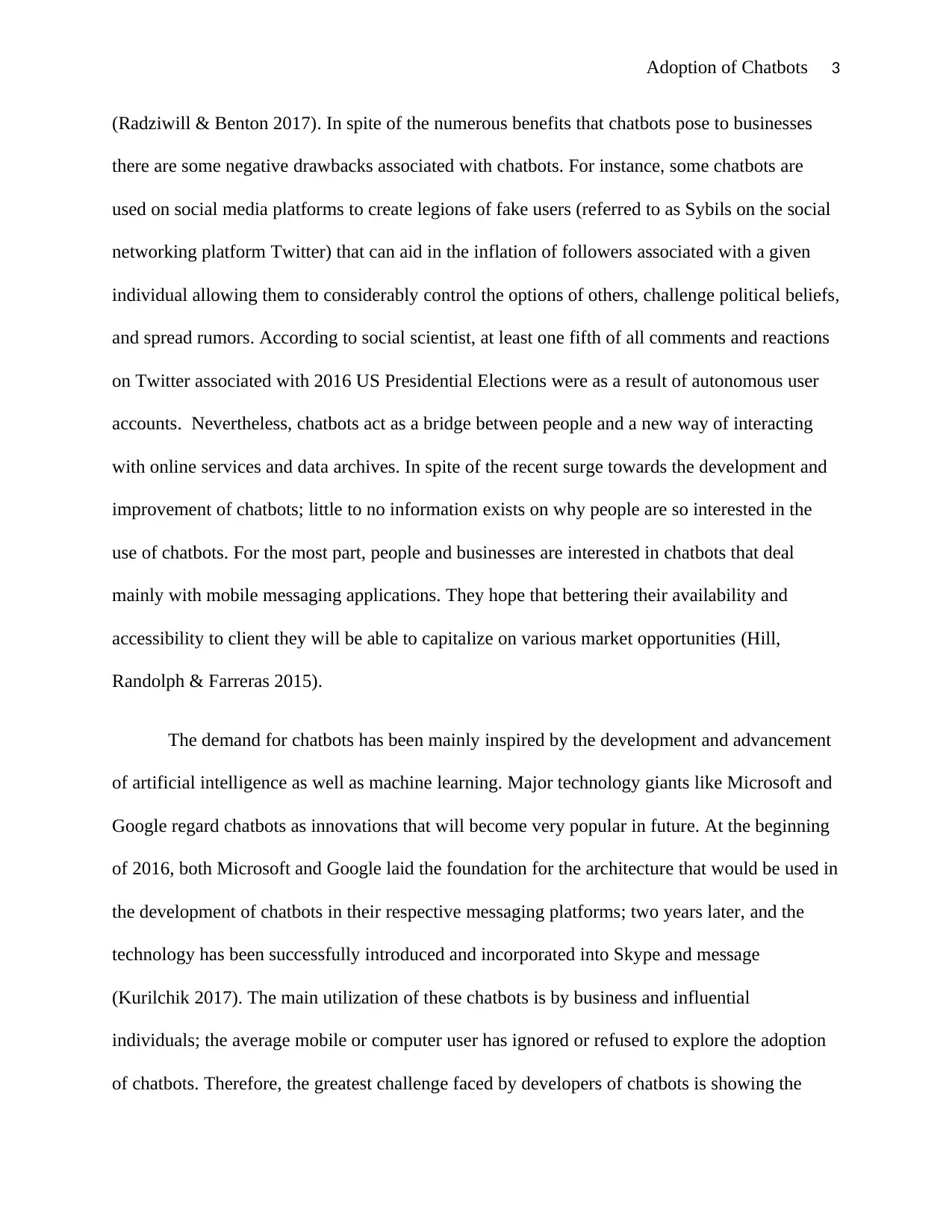
Adoption of Chatbots 3
(Radziwill & Benton 2017). In spite of the numerous benefits that chatbots pose to businesses
there are some negative drawbacks associated with chatbots. For instance, some chatbots are
used on social media platforms to create legions of fake users (referred to as Sybils on the social
networking platform Twitter) that can aid in the inflation of followers associated with a given
individual allowing them to considerably control the options of others, challenge political beliefs,
and spread rumors. According to social scientist, at least one fifth of all comments and reactions
on Twitter associated with 2016 US Presidential Elections were as a result of autonomous user
accounts. Nevertheless, chatbots act as a bridge between people and a new way of interacting
with online services and data archives. In spite of the recent surge towards the development and
improvement of chatbots; little to no information exists on why people are so interested in the
use of chatbots. For the most part, people and businesses are interested in chatbots that deal
mainly with mobile messaging applications. They hope that bettering their availability and
accessibility to client they will be able to capitalize on various market opportunities (Hill,
Randolph & Farreras 2015).
The demand for chatbots has been mainly inspired by the development and advancement
of artificial intelligence as well as machine learning. Major technology giants like Microsoft and
Google regard chatbots as innovations that will become very popular in future. At the beginning
of 2016, both Microsoft and Google laid the foundation for the architecture that would be used in
the development of chatbots in their respective messaging platforms; two years later, and the
technology has been successfully introduced and incorporated into Skype and message
(Kurilchik 2017). The main utilization of these chatbots is by business and influential
individuals; the average mobile or computer user has ignored or refused to explore the adoption
of chatbots. Therefore, the greatest challenge faced by developers of chatbots is showing the
(Radziwill & Benton 2017). In spite of the numerous benefits that chatbots pose to businesses
there are some negative drawbacks associated with chatbots. For instance, some chatbots are
used on social media platforms to create legions of fake users (referred to as Sybils on the social
networking platform Twitter) that can aid in the inflation of followers associated with a given
individual allowing them to considerably control the options of others, challenge political beliefs,
and spread rumors. According to social scientist, at least one fifth of all comments and reactions
on Twitter associated with 2016 US Presidential Elections were as a result of autonomous user
accounts. Nevertheless, chatbots act as a bridge between people and a new way of interacting
with online services and data archives. In spite of the recent surge towards the development and
improvement of chatbots; little to no information exists on why people are so interested in the
use of chatbots. For the most part, people and businesses are interested in chatbots that deal
mainly with mobile messaging applications. They hope that bettering their availability and
accessibility to client they will be able to capitalize on various market opportunities (Hill,
Randolph & Farreras 2015).
The demand for chatbots has been mainly inspired by the development and advancement
of artificial intelligence as well as machine learning. Major technology giants like Microsoft and
Google regard chatbots as innovations that will become very popular in future. At the beginning
of 2016, both Microsoft and Google laid the foundation for the architecture that would be used in
the development of chatbots in their respective messaging platforms; two years later, and the
technology has been successfully introduced and incorporated into Skype and message
(Kurilchik 2017). The main utilization of these chatbots is by business and influential
individuals; the average mobile or computer user has ignored or refused to explore the adoption
of chatbots. Therefore, the greatest challenge faced by developers of chatbots is showing the
⊘ This is a preview!⊘
Do you want full access?
Subscribe today to unlock all pages.

Trusted by 1+ million students worldwide
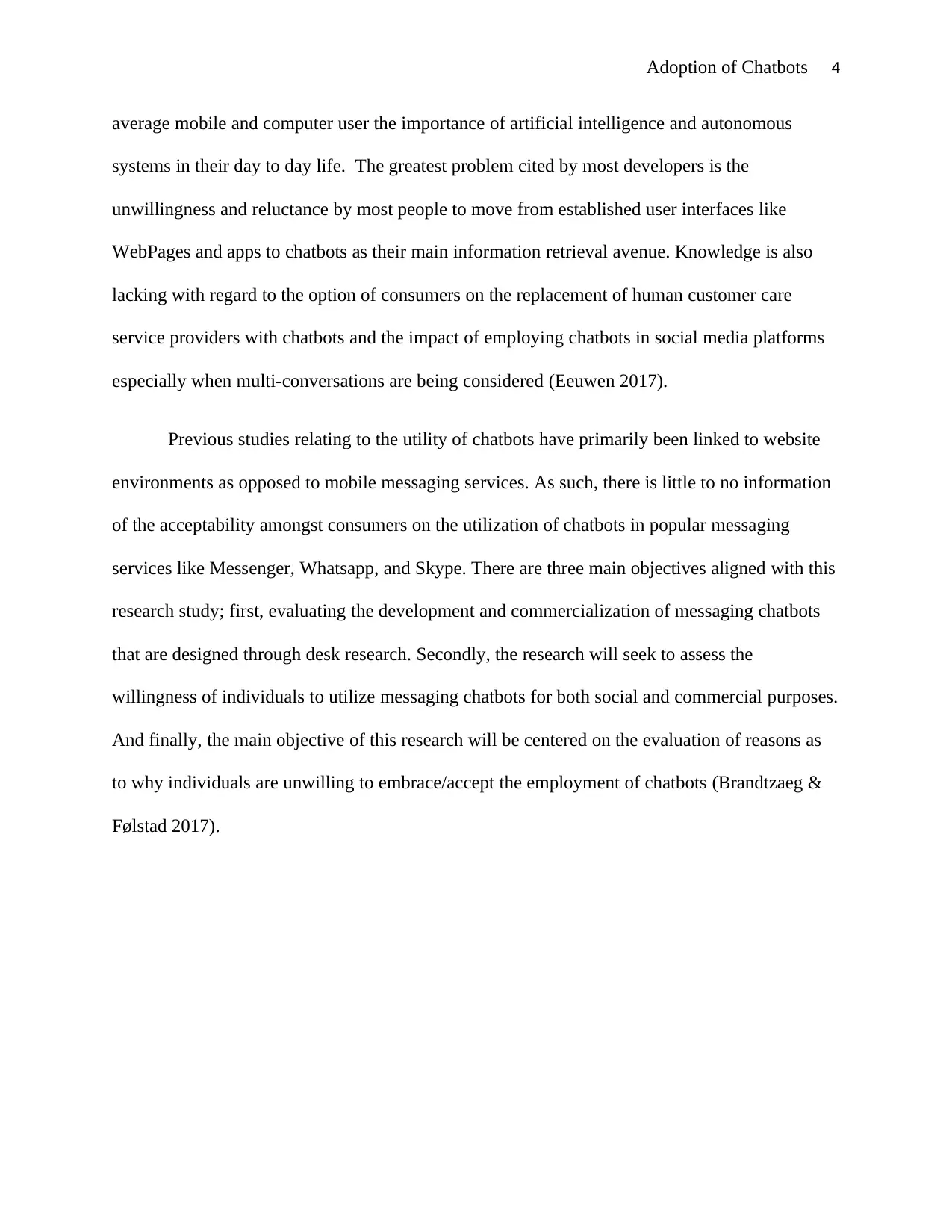
Adoption of Chatbots 4
average mobile and computer user the importance of artificial intelligence and autonomous
systems in their day to day life. The greatest problem cited by most developers is the
unwillingness and reluctance by most people to move from established user interfaces like
WebPages and apps to chatbots as their main information retrieval avenue. Knowledge is also
lacking with regard to the option of consumers on the replacement of human customer care
service providers with chatbots and the impact of employing chatbots in social media platforms
especially when multi-conversations are being considered (Eeuwen 2017).
Previous studies relating to the utility of chatbots have primarily been linked to website
environments as opposed to mobile messaging services. As such, there is little to no information
of the acceptability amongst consumers on the utilization of chatbots in popular messaging
services like Messenger, Whatsapp, and Skype. There are three main objectives aligned with this
research study; first, evaluating the development and commercialization of messaging chatbots
that are designed through desk research. Secondly, the research will seek to assess the
willingness of individuals to utilize messaging chatbots for both social and commercial purposes.
And finally, the main objective of this research will be centered on the evaluation of reasons as
to why individuals are unwilling to embrace/accept the employment of chatbots (Brandtzaeg &
Følstad 2017).
average mobile and computer user the importance of artificial intelligence and autonomous
systems in their day to day life. The greatest problem cited by most developers is the
unwillingness and reluctance by most people to move from established user interfaces like
WebPages and apps to chatbots as their main information retrieval avenue. Knowledge is also
lacking with regard to the option of consumers on the replacement of human customer care
service providers with chatbots and the impact of employing chatbots in social media platforms
especially when multi-conversations are being considered (Eeuwen 2017).
Previous studies relating to the utility of chatbots have primarily been linked to website
environments as opposed to mobile messaging services. As such, there is little to no information
of the acceptability amongst consumers on the utilization of chatbots in popular messaging
services like Messenger, Whatsapp, and Skype. There are three main objectives aligned with this
research study; first, evaluating the development and commercialization of messaging chatbots
that are designed through desk research. Secondly, the research will seek to assess the
willingness of individuals to utilize messaging chatbots for both social and commercial purposes.
And finally, the main objective of this research will be centered on the evaluation of reasons as
to why individuals are unwilling to embrace/accept the employment of chatbots (Brandtzaeg &
Følstad 2017).
Paraphrase This Document
Need a fresh take? Get an instant paraphrase of this document with our AI Paraphraser
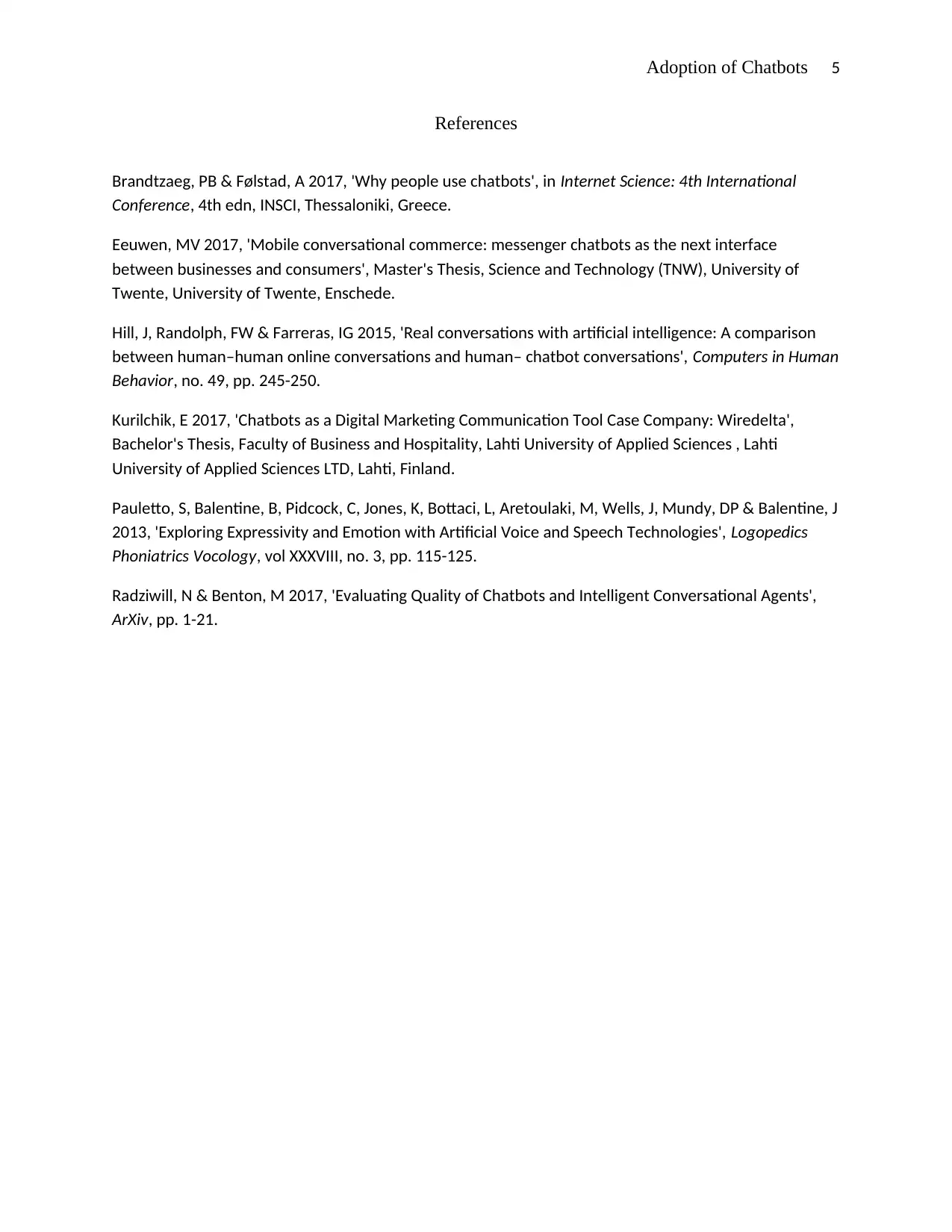
Adoption of Chatbots 5
References
Brandtzaeg, PB & Følstad, A 2017, 'Why people use chatbots', in Internet Science: 4th International
Conference, 4th edn, INSCI, Thessaloniki, Greece.
Eeuwen, MV 2017, 'Mobile conversational commerce: messenger chatbots as the next interface
between businesses and consumers', Master's Thesis, Science and Technology (TNW), University of
Twente, University of Twente, Enschede.
Hill, J, Randolph, FW & Farreras, IG 2015, 'Real conversations with artificial intelligence: A comparison
between human–human online conversations and human– chatbot conversations', Computers in Human
Behavior, no. 49, pp. 245-250.
Kurilchik, E 2017, 'Chatbots as a Digital Marketing Communication Tool Case Company: Wiredelta',
Bachelor's Thesis, Faculty of Business and Hospitality, Lahti University of Applied Sciences , Lahti
University of Applied Sciences LTD, Lahti, Finland.
Pauletto, S, Balentine, B, Pidcock, C, Jones, K, Bottaci, L, Aretoulaki, M, Wells, J, Mundy, DP & Balentine, J
2013, 'Exploring Expressivity and Emotion with Artificial Voice and Speech Technologies', Logopedics
Phoniatrics Vocology, vol XXXVIII, no. 3, pp. 115-125.
Radziwill, N & Benton, M 2017, 'Evaluating Quality of Chatbots and Intelligent Conversational Agents',
ArXiv, pp. 1-21.
References
Brandtzaeg, PB & Følstad, A 2017, 'Why people use chatbots', in Internet Science: 4th International
Conference, 4th edn, INSCI, Thessaloniki, Greece.
Eeuwen, MV 2017, 'Mobile conversational commerce: messenger chatbots as the next interface
between businesses and consumers', Master's Thesis, Science and Technology (TNW), University of
Twente, University of Twente, Enschede.
Hill, J, Randolph, FW & Farreras, IG 2015, 'Real conversations with artificial intelligence: A comparison
between human–human online conversations and human– chatbot conversations', Computers in Human
Behavior, no. 49, pp. 245-250.
Kurilchik, E 2017, 'Chatbots as a Digital Marketing Communication Tool Case Company: Wiredelta',
Bachelor's Thesis, Faculty of Business and Hospitality, Lahti University of Applied Sciences , Lahti
University of Applied Sciences LTD, Lahti, Finland.
Pauletto, S, Balentine, B, Pidcock, C, Jones, K, Bottaci, L, Aretoulaki, M, Wells, J, Mundy, DP & Balentine, J
2013, 'Exploring Expressivity and Emotion with Artificial Voice and Speech Technologies', Logopedics
Phoniatrics Vocology, vol XXXVIII, no. 3, pp. 115-125.
Radziwill, N & Benton, M 2017, 'Evaluating Quality of Chatbots and Intelligent Conversational Agents',
ArXiv, pp. 1-21.
1 out of 5
Related Documents
Your All-in-One AI-Powered Toolkit for Academic Success.
+13062052269
info@desklib.com
Available 24*7 on WhatsApp / Email
![[object Object]](/_next/static/media/star-bottom.7253800d.svg)
Unlock your academic potential
Copyright © 2020–2025 A2Z Services. All Rights Reserved. Developed and managed by ZUCOL.





